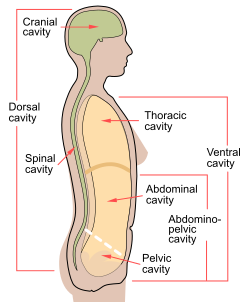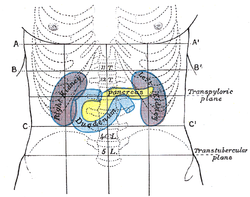Theabdominal cavityis a largebody cavityin humans[1]and many otheranimalsthat containorgans.It is a part of theabdominopelvic cavity.[2]It is located below thethoracic cavity,and above thepelvic cavity.Itsdome-shaped roof is thethoracic diaphragm,a thin sheet of muscle under the lungs, and its floor is thepelvic inlet,opening into thepelvis.
| Abdominal cavity | |
|---|---|
 | |
 | |
| Details | |
| Identifiers | |
| Latin | cavitas abdominis |
| MeSH | D034841 |
| TA98 | A01.1.00.051 A10.1.00.001 |
| TA2 | 128 |
| FMA | 12266 |
| Anatomical terminology | |
Structure
editOrgans
editOrgans of the abdominal cavity include thestomach,liver,gallbladder,spleen,pancreas,small intestine,kidneys,large intestine,andadrenal glands.[1]
Peritoneum
editThe abdominal cavity is lined with a protective membrane termed theperitoneum.The inside wall is covered by theparietal peritoneum.Thekidneysare located behind the peritoneum, in theretroperitoneum,outside the abdominal cavity. The viscera are also covered byvisceral peritoneum.
Between the visceral and parietal peritoneum is theperitoneal cavity,which is a potential space.[1]It contains aserous fluidcalledperitoneal fluidthat allows motion. This motion is apparent of thegastrointestinal tract.The peritoneum, by virtue of its connection to the two (parietal and visceral) portions, gives support to the abdominal organs.
The peritoneum divides the cavity into numerous compartments. One of these thelesser sacis located behind the stomach and joins into thegreater sacvia theforamen of Winslow.[1]Some of the organs are attached to the walls of the abdomen via folds of peritoneum andligaments,such as theliverand others use broad areas of the peritoneum, such as thepancreas.Theperitoneal ligamentsare actually dense folds of the peritoneum that are used to connect viscera to viscera or viscera to the walls of the abdomen.[1]They are named in such a way as to show what they connect typically. For example, thegastrocolic ligamentconnects thestomachandcolonand thesplenocolic ligamentconnects thespleenand the colon, or sometimes by their shape as theround ligamentortriangular ligament.[1]
Mesentery
editMesenteriesare folds of peritoneum that are attached to the walls of the abdomen and enclose viscera completely. They are supplied with plentiful amounts ofblood.The three most important mesenteries are mesentery for thesmall intestine,thetransverse mesocolon,which attaches the back portion of the colon to the abdominal wall, and thesigmoid mesocolonwhich enfolds thesigmoid colon.[1]
Omenta
editTheomentumare specialized folds of peritoneum that enclosenerves,blood vessels,lymph channels,fatty tissue, and connective tissue. There are two omenta. First, is thegreater omentumthat hangs off of thetransverse colonand greater curvature of the stomach. The other is thelesser omentumthat extends between thestomachand theliver.[1]
Clinical significance
editAscites
editWhen fluid collects in the abdominal cavity, this condition is calledascites.This is usually not noticeable until enough fluid has collected to distend the abdomen. The collection of fluid will cause pressure on the viscera,veins,andthoracic cavity.Treatment is directed at the cause of the fluid accumulation. One method is to decrease theportal veinpressure, especially useful in treatingcirrhosis.Chylous ascitesheals best if the lymphatic vessel involved is closed.Heart failurecan cause recurring ascites.[1]
Inflammation
editAnother disorder is calledperitonitiswhich usually accompanies inflammatory processes elsewhere. It can be caused by damage to an organ, or from a contusion to the abdominal wall from the outside or by surgery. It may be brought in by the bloodstream or thelymphaticsystem. The most common origin is thegastrointestinal tract.Peritonitis can beacuteorchronic,generalized or localized, and may have one origin or multiple origins. Theomentacan help control the spread of infection; however without treatment, the infection will spread throughout the cavity. Anabscessmay also form as a secondary reaction to an infection.Antibioticshave become an important tool in fighting abscesses; however, external drainage is usually required also.[1]
See also
editReferences
edit- ^abcdefghij"Abdominal cavity".Encyclopædia Britannica.Vol. I: A-Ak – Bayes (15th ed.). Chicago, Illinois: Encyclopædia Britannica, Inc. 2010. pp.19–20.ISBN978-1-59339-837-8.
- ^Wingerd, Bruce (1994).The Human Body: Concepts of Anatomy and Physiology.Fort Worth: Saunders College Publishing. pp. 11–12.ISBN0-03-055507-8.